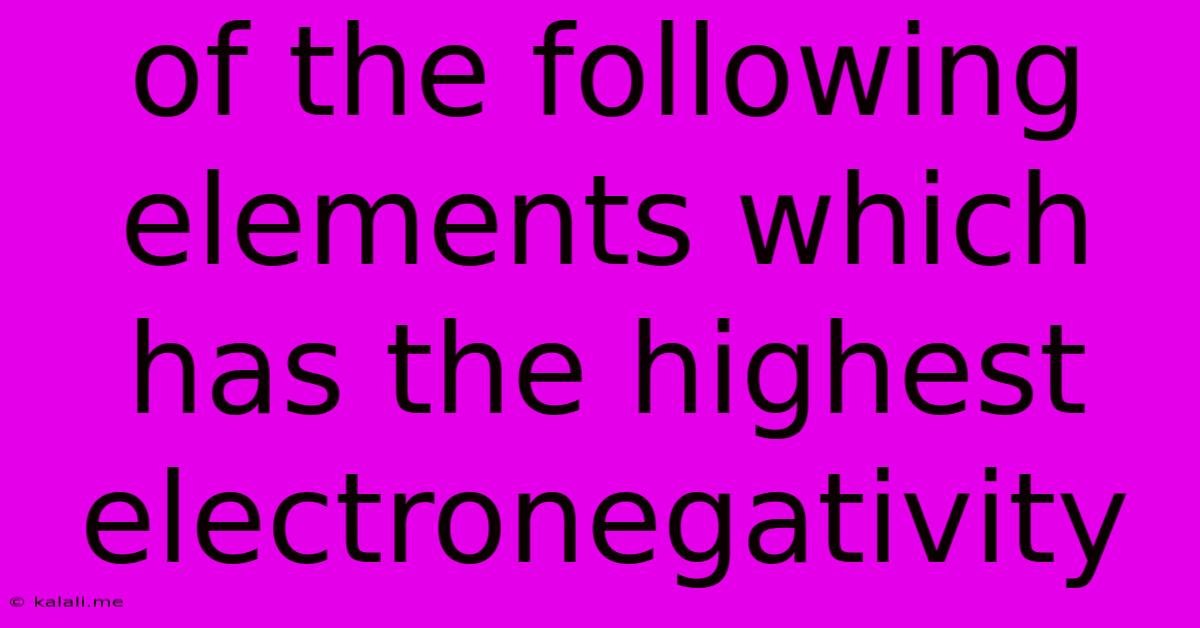Of The Following Elements Which Has The Highest Electronegativity
Kalali
Jun 12, 2025 · 3 min read

Table of Contents
Of the Following Elements, Which Has the Highest Electronegativity? A Deep Dive into Electronegativity Trends
Electronegativity, a crucial concept in chemistry, describes an atom's tendency to attract electrons towards itself within a chemical bond. Understanding electronegativity is key to predicting the polarity of bonds and the overall properties of molecules. This article will explore electronegativity trends and answer the question: Which element generally exhibits the highest electronegativity? We will also discuss factors influencing electronegativity and provide examples.
What is Electronegativity?
Electronegativity is a relative property; it's a measure of how strongly an atom attracts electrons compared to other atoms. Higher electronegativity means a stronger pull on shared electrons in a covalent bond. This attraction influences bond polarity, leading to polar or nonpolar molecules, which in turn affects physical and chemical properties like melting point, boiling point, and solubility. Several scales exist to quantify electronegativity, the most common being the Pauling scale.
Periodic Trends in Electronegativity
Electronegativity isn't a directly measurable quantity, but it follows predictable trends across the periodic table:
-
Increases across a period (left to right): As you move from left to right across a period, the number of protons in the nucleus increases, while the principal quantum number (shell number) remains the same. This leads to a stronger positive charge attracting the electrons more strongly.
-
Decreases down a group (top to bottom): As you move down a group, the atomic radius increases significantly. The outermost electrons are further from the nucleus, experiencing a weaker effective nuclear charge and consequently exhibiting lower electronegativity.
The Element with the Highest Electronegativity:
Based on the periodic trends, elements located in the upper right-hand corner of the periodic table (excluding noble gases) generally possess the highest electronegativity. While the exact value might vary slightly depending on the scale used, fluorine (F) consistently exhibits the highest electronegativity. Its small atomic radius and high effective nuclear charge contribute to its strong attraction for electrons.
Factors Affecting Electronegativity:
Several factors influence an atom's electronegativity:
-
Nuclear Charge: A higher nuclear charge leads to stronger attraction for electrons.
-
Atomic Radius: Smaller atoms have electrons closer to the nucleus, experiencing a stronger pull.
-
Shielding Effect: Inner electrons shield the outer electrons from the full positive charge of the nucleus, reducing the effective nuclear charge and thus the electronegativity.
-
Electron Configuration: Atoms with nearly complete valence shells tend to have higher electronegativity as they are strongly inclined to gain electrons to achieve a stable octet configuration.
Examples Illustrating Electronegativity Differences:
Consider the bond between hydrogen (H) and chlorine (Cl) in hydrogen chloride (HCl). Chlorine has a significantly higher electronegativity than hydrogen. This leads to a polar covalent bond, with the electrons being more closely associated with the chlorine atom, creating a partial negative charge (δ-) on chlorine and a partial positive charge (δ+) on hydrogen.
In contrast, a bond between two identical atoms, such as in oxygen gas (O2), is nonpolar because both oxygen atoms have the same electronegativity, leading to an equal sharing of electrons.
Conclusion:
While other elements such as oxygen and nitrogen exhibit high electronegativity, fluorine consistently holds the title of the element with the highest electronegativity. Understanding electronegativity trends is essential for predicting the behavior of molecules and their interactions. This fundamental concept underpins many aspects of chemical bonding and reactivity.
Latest Posts
Latest Posts
-
Which Of The Following Reactions Is Not A Redox Reaction
Jun 13, 2025
-
In The Third Sentence Of The First Paragraph
Jun 13, 2025
-
California Polytechnic State University Sat Scores
Jun 13, 2025
-
How Many Lakhs Is A Million
Jun 13, 2025
-
Which Of The Following Is Correctly Matched A
Jun 13, 2025
Related Post
Thank you for visiting our website which covers about Of The Following Elements Which Has The Highest Electronegativity . We hope the information provided has been useful to you. Feel free to contact us if you have any questions or need further assistance. See you next time and don't miss to bookmark.